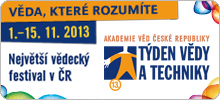The Director of the Institute of Art History, Academy of Sciences of the Czech Republic, Prof. Vojtěch Lahoda, was involved in the preparation of the international exhibition Cubisti Cubismo, which is open from 8 March to 23 June 2013 at the Complesso Monumentale del Vittoriano in Rome. The curator, Charlotte N. Eyerman, an art historian from Los Angeles, planned it as a wide-ranging survey of Cubists and Cubism, from Picasso, through Russian artists, to figures from the USA (Max Weber) and Great Britain (Wyndham Lewis). She presented Cubism as a trend that eventually influenced all local schools, and emphasised the spread of Cubism into decorative art, architecture (Czech examples were at least shown in photographs and a model of Chochol’s house in Neklanova Street), and into film.
Czech participation in the exhibition suffers as a result of the well-known restriction on
lending works of art, due to the unresolved case of Diag Human. Czech paintings are therefore
represented by a single work, František Foltýn’s
Portrait of Dostojevsky from 1922.
In the exhibition catalogue, which has the same title and is published by the SKIRA publishing
house, Vojtěch Lahoda considers the “forgotten” Cubism to the east of Paris (C´era una volta l´Est:
il cubismo perduto, pp. 85–101). The focus is understandably on Cubism in the Czech lands, which is
examined by means of terms such as “remake” or “transfer”. Apart from its emphasis on the Czech
setting, the strategy of communication with Paris, and ways of obtaining photographs of the most
up-to-date developments, the article also stresses the Cubist “heterogeneous” exploits in Polish,
Latvian, Hungarian, and Romanian Modernism. Mention is made of solitary artists, such as the
Lithuanian Vytautas Kairiūkštis, whose
Cubist Composition from 1921 is reproduced in the catalogue, together with Kubišta’s
Hypnotiser (1912) from the Gallery of Fine Arts in Ostrava and Filla’s
The Head of an Old Man (1914) from the West Bohemian Gallery in Plzeň. The catalogue
contains studies, published only in Italian, by Charlotte Eyerman, David Cottington, Kenneth E.
Silver, Christopher Reed, William H. Robinson, Nina Gurianova, Vojtěch Lahoda, Simonetta Lux and
Massimiliano Lopez.
Associate Professor of the Western Illinois University in Macomb, examines in his lecture held
on 12 June 2013 at 3.30 p.m. in the Institute of Art History, Husova 4, Prague 1, room 117, newly
available letters by and about Oskar Kokoschka from Moscow and Zürich archives. This lecture
revises extant interpretations of his art and activities in Czechoslovakia (1934–1938). Kokoschka's
public role as an outspoken advocate for human rights, his pursuit of democracy through educational
reform (the Volkshochschule movement), and his role as a critic of fascist governments are related
to his less understood, but elaborate, network of supporters, friends and family within and beyond
the borders of the Republic.








